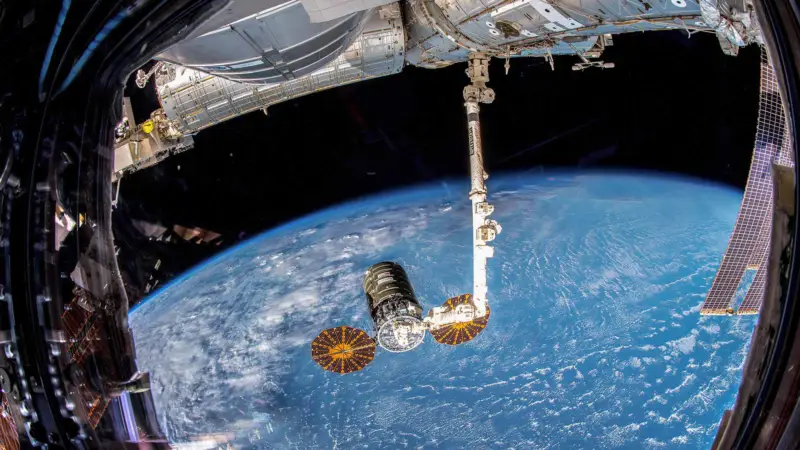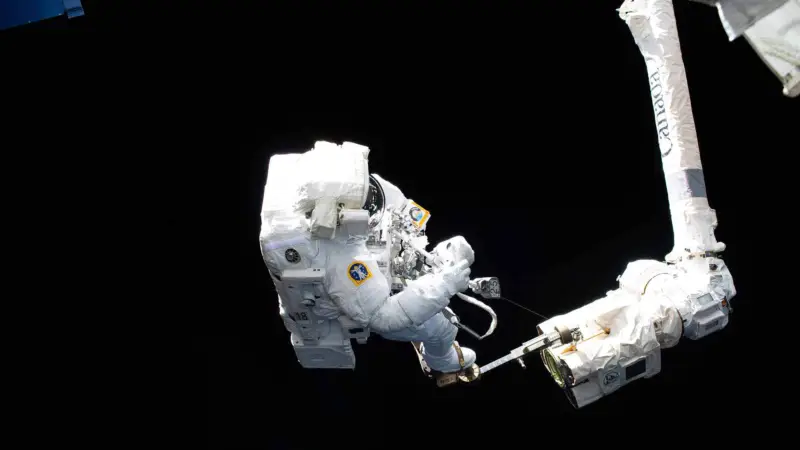Robotics & Space Operations
At the forefront of humanity’s exploration of space
As the designer and developer of the iconic Canadarm family of space robotics for the Canadian Space Agency (CSA) and NASA, MDA robotic technology and services have helped enable space exploration, space science and space safety for decades.
Our original Canadarm robotic technology first launched aboard Space Shuttle Columbia in 1981 and flew on 90 missions until the end of the program in 2011. The next generation of this technology followed in 2001 with the installation of Canadarm2 on the International Space Station (ISS) and in 2008 with the launch of Dextre, the world’s most sophisticated space robot.
MDA robotic systems continue to perform maintenance and inspection, relocate assets, help capture and berth arriving spacecraft, and support astronaut spacewalks today. With the flexibility to be controlled by astronauts on board the ISS or by Earth-based ground operators, the mobile robotic servicing system also helps to reduce the frequency of required spacewalks allowing astronauts more time to spend on mission-related duties inside the space station.
In recent years, the CSA and MDA have undertaken our most ambitious space exploration project yet. Canadarm3 is destined to operate aboard “Gateway”, a deep space outpost that will orbit the Moon beginning in the mid-2020s, supporting both human and robotic missions to the lunar surface, serving as a science laboratory, and acting as a proving ground for exploration missions into deeper space. With extremely limited connectivity and significant latency due to the Gateway’s location some 400,000 km from Earth, Canadarm3 will be designed to be highly autonomous, using its advanced AI-enabled sensors and systems to make decisions when astronauts are not present.
We are leveraging our work on Canadarm3 into commercial opportunities in the space exploration segment of the growing global space economy, including satellite servicing, space debris monitoring and removal, space tourism and space manufacturing.
In addition to robotic arms, our suite of robotics and space operations solutions includes electro-optic and LiDAR sensors, robotic interfaces, robotic ground operations and engineering, vision systems, guidance/navigation/control subsystems, and rover locomotion subsystems. With a full suite of modern, advanced and autonomous robotics and vision sensors capable of operating in space and on the surfaces of the Moon, Mars and beyond, MDA remains at the forefront during a new era of space agency and commercial innovation and exploration.
5,844
Number of times the ISS orbited the Earth
6,650
Robotics commands executed
128
Days that that robotic operations were performed
27
Robotically performed health inspections of ISS components or visiting spacecraft
A mission critical partner for customers around the globe
MDA’s broad range of innovative technologies are used by international space agencies, commercial partners, and astronauts for exploration mobility, manipulation, control and autonomy, and docking and landing.
- We have provided key sensors and robotics to missions such as NASA’s Mars Phoenix lander and Mars Curiosity rover, as well as critical locomotion and vision systems for the European Space Agency’s ExoMars rover mission.
- MDA robotics and sensors are routinely used to capture and berth visiting spacecraft to the ISS and to assist in docking operations – and next-generation versions will be used to land spacecraft on the Moon and Mars.
- Our LiDAR sensors, critical to rendezvous, docking, inspection, and landing activities as part of on-orbit and planetary missions, helped the OSIRIS-REx mission scan the asteroid Bennu from 300 kilometres away, conducting the world’s first 3D scan of an asteroid from an orbiting spacecraft.
- MDA has been servicing space infrastructure for over 40 years. We designed and built the robotic system on the Orbital Express mission, which enabled the world’s first autonomous on-orbit servicing demonstration proving that a robotic spacecraft could safely and cost-effectively service a satellite while in orbit.
- The Space Shuttle’s original Canadarm participated in five servicing missions to extend the life and upgrade the Hubble Space Telescope. Meanwhile, Canadarm2 on the ISS is evolving to perform operations with greater autonomy, paving the way for AI-enabled autonomous operations in deeper space.
MDA is now enabling multiple next generation space missions where our technology and on-orbit experience provides the foundation for new and innovative developments – such as advancing space infrastructure servicing, assembly and maintenance; the construction of commercial human habitats in space; and exploring the lunar surface and beyond.
15
Payloads grabbed by Dextre
9
Spacewalks supported by MDA-built robotics
5
Capture and release of visiting free-flying spacecraft
4
Payloads grabbed by Canadarm2






